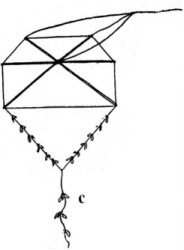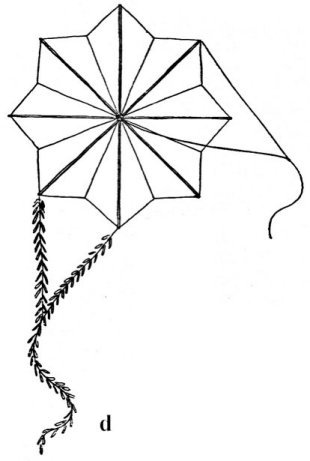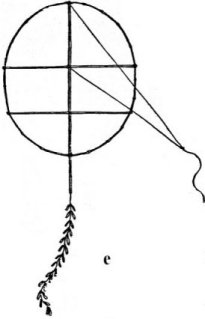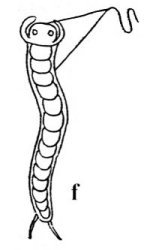51. Lu-pe - KITES

Kites are made of kapa cloth with sticks (la-au lu -pe) of wi-li-wi-li wood. Six forms were described by my informants: lu -pe ma-nu, or "bird kite"; lu-pe hui-na-ha, or "four-sided kite"; lu-pe le-le; lu-pe ho-ku, "star kite"; lu-pe ma-hi-ni, " moon kite" ; and lu -pe ka-na-pi, "centipede kite." These are illustrated in Plate XVI.

The first (Plate XVI, a) has a bow of bamboo and two sticks crossed at right angles; the triangles above and below the bow are bound with cord (kau-la ku-i-na); tails (hu-e-lo, we-lo-we-lo) are fastened at the sides, but none at the extremity.
The four-sided kite has two crossed sticks with two binding sticks and is lashed with cord about the edges; it has a long tail with strips of kapa attached called kai-kai-a-po-la (Plate XVI, b).
 The lu-pe le-le (Plate
XVI, c) has a similar long tail. The lu-pe ho-ku, or "star kite"
(Figure d) has four sticks crossed in the middle, the edge being formed
by a cord tied with a radial cord between each of the sticks. The lu -pe
ma-hi-ni, or "moon kite" (Figure e), has three sticks, a long
vertical one, crossed by two parallel horizontal sticks, and an exterior hoop of
bamboo. Both star and moon kites have tails (kai-kai-a-la).
The lu-pe le-le (Plate
XVI, c) has a similar long tail. The lu-pe ho-ku, or "star kite"
(Figure d) has four sticks crossed in the middle, the edge being formed
by a cord tied with a radial cord between each of the sticks. The lu -pe
ma-hi-ni, or "moon kite" (Figure e), has three sticks, a long
vertical one, crossed by two parallel horizontal sticks, and an exterior hoop of
bamboo. Both star and moon kites have tails (kai-kai-a-la).
The kite strings (a-ho) are made of kapa. Men fight kites, one man entangling (hoo-wi-u-wi-u) his line with another's and endeavoring to bring down his antagonist's kite. They bet on the result. The kite called lu-pe le-le is said to be used invariably for this purpose.

Concerning Kites in Tahiti, Ellis1 says: "The boys were very fond of the uo, or kite, which they raised to a great height. The Tahitian kite was different in shape from the kites of the English boys. It was made of light native cloth instead of paper, and formed in shape according to the fancy of its owner."

Taylor2 describes the New Zealand kite under the name of to kahu, or he manu waka-tuku-tuku, he pakau. "The name kahu is that of a bird like the hawk. Their figure is generally a rough imitation of that bird, with its great outspread wings. These kites are frequently made of very large dimensions of raupo leaves, a kind of sedge, neatly sewed together, and kept in shape by a slight frame-work."
Dieffenbach3 says of the New Zealand kite: "Their kite (manu or pakau pakaukau) is of a triangular form, and is neatly made of the light leaves of a sedge; it is held by a string made of strips of flax tied together, and its ascent is accompanied with some saying or song. It is a sign of peace when it is seen flying near a village."
Rev. William Wyatt Gill4 says of kite-flying:
"In times of peace this was the great delight of aged men. Kites were usually five feet in length, covered with native cloth, on which were the devices appropriate to their tribe - a sort of heraldry. The tail was twenty fathoms in length, ornamented with a bunch of feathers and abundance of sere ti leaves. Parties were got up of not less than ten kite-flyers, the point of honor being that the kite should fly high and be lost to view in the clouds. Songs made for the occasion were chanted meantime. It was no uncommon event for them to sleep on the mountain, after well securing the kites to the trees. Of course the upshot of all this would be a grand feast, in which the victor got the biggest share. So serious was this employment that each kite bore its own name, and tears of joy were shed by these grey-bearded children as they witnessed the successful flight. When desirous at length of putting an end to their sport, if the wind were too strong to allow the string to be pulled in, it was customary to fill a little basket with mountain fern or grass and whirl it along the string. The strong trade winds would speedily convey this 'messenger' to the kites, which then slowly descended to the earth. Children's kites were, and still are, extemporized out of the leaves of the gigantic chestnut tree. Sometimes one sees a boy (no longer grandfathers) flying a properly made kite.

Wilkes5 says of the Kingsmill islanders , that their kites are made of pandanus-leaf, reduced to half its thickness, which renders it lighter than paper, and they are prettily shaped.
Codrington6 says:
Kites, used in fishing in the Solomon islands and Santa Cruz, are used as toys in the Banks' islands and New Hebrides, though not commonly of late years. They have their season, being made and flown when the gardens are being cleared for planting. The kite is steadied by a long reed tail, and a good one will fly and hover very well. The name is in Banks' islands rea, in Lepers' island mala, an eagle.
Notes:
1. Op. Cit., Vol. I, p. 228.
2. OP. Cit, p. 172.
3. Vol. II., p. 31.
4. From Darkness to Light in Polynesia, London, 1894, p. 39.
5. Vol. V, p. 100.
6. Page 342.
Last update February 2, 2010